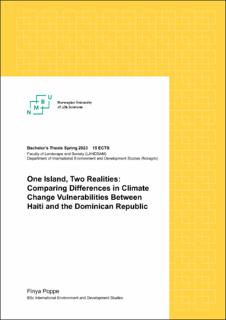| dc.description.abstract | Increasing levels of greenhouse gas emissions in the earth’s atmosphere are leading to global warming, which, over time, has been changing the planet’s climate and will continue to do so in the future (Intergovernmental Panel on Climate Change, 2021). This global change increases uncertainty about the timing, occurrence, and extent of climate change related hazards. However, hazards do not automatically translate into disasters as vulnerability plays a key role in this scenario. This thesis uses the Pressure and Release (PAR) model by Wisner et al. (2004) to examine how the vulnerabilities of the Republic of Haiti and the Dominican Republic are different from each other with regards to current and future climate change events. Furthermore, I investigate the reasons for these differences. This is particularly interesting because the two countries share one island yet differ significantly in their resilience to climate change hazards. The analysis shows that vulnerabilities persist in both Haiti and the Dominican Republic. However, they do so to different degrees and in slightly different areas, rooted in an intertwined but unalike history of the two countries. Haiti’s main restraint is weak governance, which inhibits the country’s economic and social development, while the Dominican Republic deliberately increases the vulnerabilities of Haitian descendants. Both countries must focus on increasing resilience in urban areas as the majority of the island’s inhabitants will be living there, and they function as sites for livelihood generation and overall economic activity. Furthermore, reforestation and sustainable agriculture are crucial for reducing vulnerabilities to climate change hazards in the long term. | en_US |

